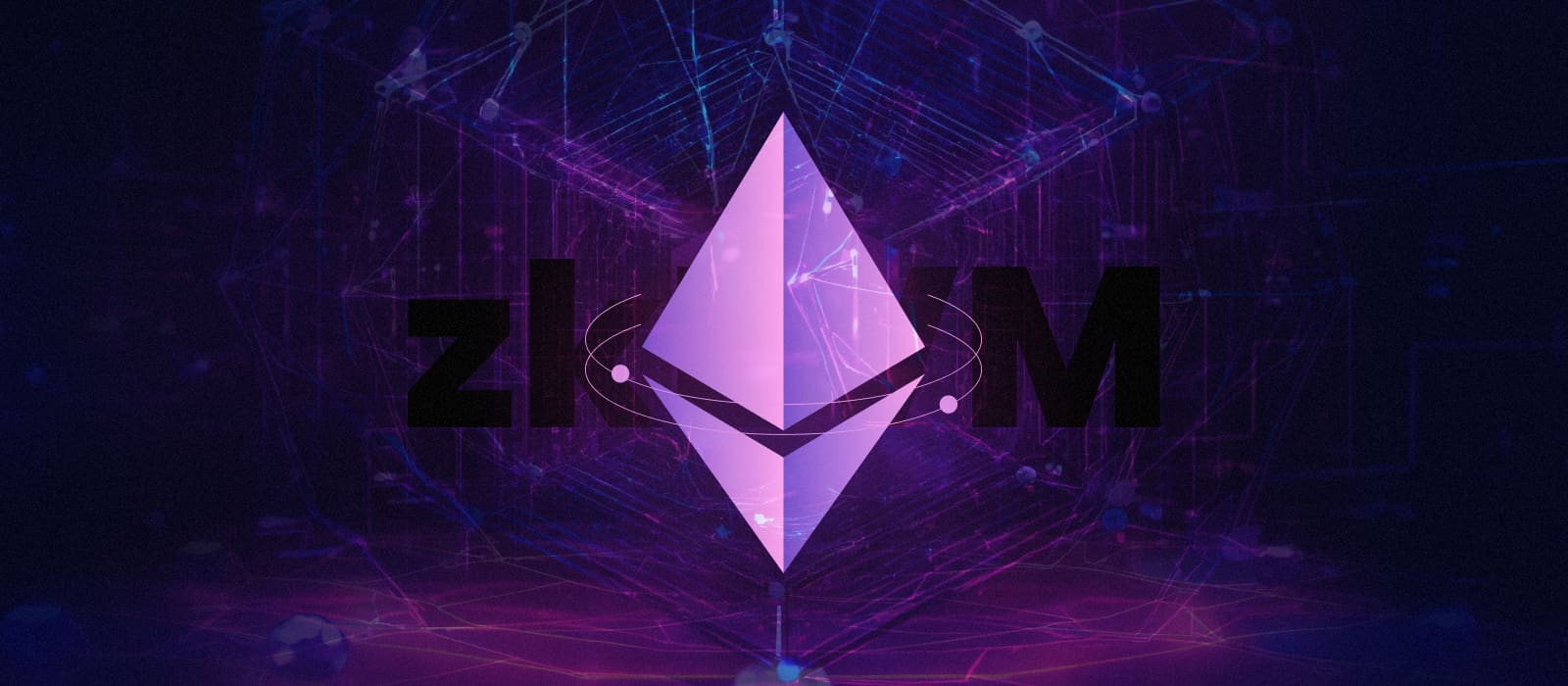The pressing challenges of scalability and privacy have long hindered blockchain’s wide enterprise-level adoption. zkEVM stands as an elegant response that offers a revolutionary approach to smart contract execution, ensuring privacy and efficiency.
The allure of zkEVM extends far beyond its technical prowess: it promises tangible benefits for businesses and developers alike.
By enabling Ethereum applications to scale securely and efficiently, zkEVM opens up new horizons for enterprise-level blockchain solutions. Its compatibility with existing Ethereum infrastructure means a seamless transition for developers, while businesses stand to gain from its enhanced transaction speed and reduced costs.
Eager to understand how zkEVM ecosystem can transform your blockchain experience? Read on to explore its intricate workings, benefits, and the potential it holds for the future of decentralized applications.
What is a zkEVM?
A zkEVM, or zero-knowledge Ethereum virtual machine, is an advanced technological solution that supports zero-knowledge proof (ZKP) computations to enhance the Ethereum blockchain’s scalability, security, and decentralization.
ZKPs are cryptographic protocols that validate transaction data within a ZK rollup, a type of a Layer 2 scaling solution, without revealing any underlying information. This ensures enhanced security while significantly reducing the burden on the mainnet, leading to faster transactions.
Since zkEVM is compatible with Ethereum virtual machine, it means that existing Ethereum decentralized applications (dApps) can migrate to zkEVM without having to alter their codebase.
To put it simply, zkEVM acts like a bridge that connects the benefits of zero-knowledge proofs with the Ethereum infrastructure. It enables Ethereum applications to operate at higher speeds and with greater scalability, all while maintaining the security and decentralization that the Ethereum network is known for.
Leverage our expertise in Ethereum development to innovate and excel in the blockchain space
How does zkEVM work? Delving into zkEVM architecture
To understand how zkEVM works, let’s take a look at its architecture and discuss each unique component.
![]()
The zkEVM architecture is structured into three primary components: an execution environment, a proving circuit, and a verifier contract. These components ensure seamless program execution, the generation of proofs, and the verification of processes within the zkEVM system.
- Execution environment
This is the space where the zkEVM runs its programs, akin to smart contracts. It operates similarly to the EVM, processing the initial state and the current transaction to derive a new state.
- Proving circuit
The proving circuit’s role is to create zero-knowledge proofs that confirm the accuracy of transactions processed in the execution environment. This involves using the pre-state, transaction inputs, and post-state to generate a concise proof, affirming the legitimacy of the state transition.
- Verifier contract
In Ethereum’s traditional model, every transaction is verified by each node on the network, which is a resource-intensive approach. ZK rollups streamline this process by bundling many transactions into a single batch and using a zero-knowledge proof to verify their correctness. This batch is further published on Ethereum.
Verifier contract plays a crucial role in this process. It receives validity proofs from these Layer 2 ZK rollups. By analyzing the zero-knowledge proof, the verifier contract determines if the final outputs are accurately derived from the initial state. Essentially, it confirms that the updated state of these bundled transactions is correct without needing to individually process each transaction, thus maintaining efficiency and security in the network.
So, here is what the entire process looks like step-by-step:
- zkEVMs start by accessing bytecode to verify that the virtual machine is loading the correct smart contract logic from the right address.
- Before processing any transactions, zkEVMs perform the necessary checks to ensure that the smart contract retrieves the correct values from the storage. This helps ensure the accuracy of the transaction.
- After executing a smart contract, zkEVMs verify the correctness of the output values, thus ensuring that the smart contract execution results are as expected.
- The final step involves zkEVMs dealing with computation verification to guarantee the correct execution of opcodes.
Explore our smart contract development services and see how we can assist you with your next blockchain-based project
What are the benefits of zkEVMs?
![]()
Secure scalability, fast finality, programmability, enhanced privacy, and reduced cost are key benefits of zkEVM. Let’s briefly discuss each of these.
Secure scalability
Unlike many blockchain solutions that make certain security assumptions, zkEVMs rely on provably legitimate computation. Although zkEVMs function independently of Ethereum’s consensus rules, they verify all Layer 2 transactions on Ethereum’s Layer 1 using validity proofs.
This architecture ensures that zkEVMs can optimize for both high-speed transaction processing and large transaction volumes, without sacrificing security or decentralization, a common issue with other blockchain solutions like sidechains and rollups.
Fast finality
In blockchain, finality is the amount of time it takes for a transaction to become irreversible. Unlike traditional blockchain networks where confirmations can take longer, the use of zkEVMs ensures that transactions are finalized rapidly, enhancing user experience and efficiency in transaction processing.
Programmability
zkEVMs are compatible with Ethereum’s smart contract programming, allowing developers to use familiar tools and languages. This programmability means that Ethereum apps can be easily adapted to zkEVM, facilitating a smooth transition.
Enhanced privacy
By leveraging zero-knowledge proofs, zkEVMs allow the verification of transactions without revealing the underlying data, ensuring user privacy and data protection within the network.
Reduced cost
By processing transactions off-chain and only submitting proof of these transactions to the Ethereum mainnet, zkEVMs significantly reduce the gas fees associated with transaction processing. This cost-efficiency makes it an attractive option for users and developers who are looking to minimize expenses.
Comparing zkEVMs to other scaling solutions
There are several other solutions on the market, including sidechains and ZK rollup solutions, that aim at enhancing Ethereum’s scalability. But how do they differ from each other?
Let’s walk through each of them to understand their features and how they contribute to solving scalability challenges.
Sidechains
Sidechains are separate blockchains that run in parallel to the mainnet. They have their own consensus mechanisms and can function with different rules, handling transactions independently.
Sidechains typically offer faster and cheaper transactions, but the decentralization and security levels might not always match those of the main Ethereum blockchain.
Meet Echo DeFi — a cutting-edge DeFi solution with a comprehensive sidechain mechanism
Rollups
Rollups are Layer 2 networks that process transactions on a separate chain and consolidate them into batches. They use smart contracts to transmit and publish information on Ethereum. There are two types of rollups: optimistic rollups and zk-proofs.
Optimistic rollups assume transactions are valid by default and only run computation in the event of a dispute. This “optimistic” assumption allows them to handle transactions off the main Ethereum chain, thereby reducing the load.
They have a longer finality time due to a challenge period, during which transactions can be disputed for incorrectness. This period is essential for maintaining security but can delay transaction finalization.
ZK-rollups bundle transactions and use zero-knowledge proofs to validate these transactions. This method compresses transaction data and verifies its correctness without revealing the underlying data.
While they provide strong security guarantees, zk-rollups require more complex technology and may have some limitations in terms of the types of computations they can handle.
Check out a detailed comparison of the most popular Layer 2 solutions
What are the challenges in developing zkEVMs?
The Ethereum virtual machine was not originally designed to accommodate zk-proof computation, leading to certain characteristics that pose challenges for proving circuits. Building zkEVMs becomes difficult due to the four key aspects: special opcodes, stack-based architecture, storage complexity, and proving costs.
Special opcodes
The Ethereum virtual machine contains unique opcodes to instruct the EVM to do a specific action when executing a smart contract, for example, CALL or DELEGATECALL. These opcodes are not inherently compatible with zk-proof systems and need to be adapted to be able to work within a zero-knowledge proof framework.
Stack-based architecture
The EVM leverages a stack-based architecture that applies the last in, first out (LIFO) principle. This implies that the last data added to the call stack is the first one to be removed.
Although this architecture is simpler than a registered-based model, it is more difficult to prove computation in it.
Storage complexity
Since the EVM’s storage mechanism relies on Keccak hashing functions and a Merkle Patricia Trie. Both of them can lead to overhead issues in a zk-proof environment. Managing and optimizing storage to work efficiently with zk-proofs is a considerable challenge.
Proving costs
Generating zk-proofs, especially in a system not initially built for them, can be resource-intensive and costly. It requires specialized software along with investment in time and effort.
Current types of functioning zkEVMs
![]()
At present, there are three popular functional zkEVMs: Polygon zkEVM, zkSync Era, and ConsenSys zkEVM.
Let’s discuss each project in detail.
Polygon zkEVM
Polygon zkEVM is a zero-knowledge virtual machine that leverages the power of ZK proofs to increase throughput and reduce transaction costs while maintaining the security of Ethereum Layer 1.
Polygon zkEVM offers seamless integration with the existing Ethereum ecosystem. Developers can simply copy-paste their existing smart contracts without any modifications. This compatibility extends to the use of familiar code, tooling, and applications, just like on Ethereum, but with the added benefits of higher throughput and lower fees.
Polygon zkEVM utilizes intelligent parallel operation of several provers. It leverages SNARKs (Succinct Non-Interactive Arguments of Knowledge) for size optimization, while initially employing STARKs (Scalable Transparent ARguments of Knowledge) for quicker proof generation.
zkSync Era
Developed by Matter Labs, zkSync Era is another zero-knowledge rollup that is compatible with the EVM, supporting a broad range of EVM smart contracts.
Besides opcode and gas metering differences, the zkSync Era’s zkEVM closely follows the EVM programming model and its invariants, including ABI calling conventions.
ZkSync Era employs its LLVM compiler to convert code from common EVM languages like Solidity, Vyper, and Yul for their zkEVM. Future plans include extending this compiler to support Rust and C++ as well. This enables developers to easily migrate EVM smart contracts without needing to rewrite code in a new language or tool.
ConsenSys zkEVM
Similar to Polygon zkEVM, ConsenSys zkEVM boats 100% bytecode compatibility, ensuring maximum compatibility with all EVM-compatible chains.
By using zero-knowledge proofs, ConsenSys zkEVM efficiently processes a large number of transactions off-chain and then batches these transactions to the Ethereum mainnet.
An additional benefit of ConsenSys zkEVM is its design for minimal onboarding time. The rollup simplifies the complexities associated with zero-knowledge proofs, utilizes ETH for gas payments, and operates independently of third-party transpilers or specialized middleware.
Future of zkEVMs
The future of zkEVMs looks promising and dynamic, with numerous new projects, such as Scroll and Taiko, nearing public release. While Ethereum is still working towards solving scalability issues, Layer 2 solutions like zkEVMs continue to address these critical challenges, focusing on security, throughput, decentralization, and scalability.
zkEVMs represent years of research and development, culminating in a system that paves the way for immediate development of scalable, Ethereum-compatible applications.
For those looking to navigate and leverage these advancements in Ethereum’s blockchain technology, PixelPlex offers expert ZK rollup development services. Reach out to PixelPlex to explore how zkEVMs can transform your blockchain projects and align with your strategic goals.




